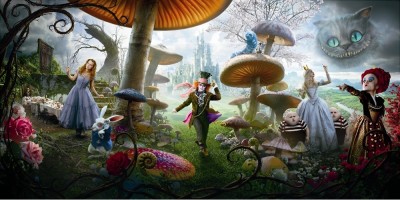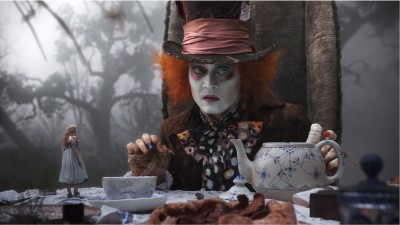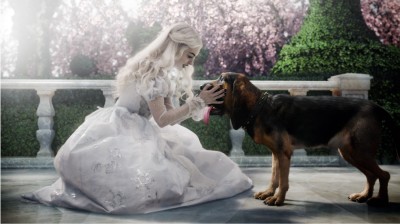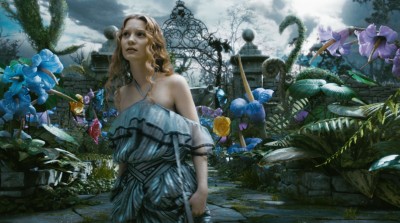By: debbie lynn elias In 1865, Reverend Charles Lutwidge Dodgson, a mathematics professor at Christchurch University in Oxford, England forever changed the world. No, he didn’t disprove the Pythagorean Theory or find a new way to alter tax percentages to help the people. What he did do was much more amazing and wonderful.
In 1865, Reverend Charles Lutwidge Dodgson, a mathematics professor at Christchurch University in Oxford, England forever changed the world. No, he didn’t disprove the Pythagorean Theory or find a new way to alter tax percentages to help the people. What he did do was much more amazing and wonderful.
Reverend Dodgson, under the pen name of Lewis Carroll, created the incredible, fantastical and imaginative world of Wonderland and began to write stories about a little girl named Alice. With its bizarre stylization, unique and challenging word play, unforgettable characters, a strange and wondrous world down a rabbit hole where time and size are everchanging, and a never ending appeal that touches the imaginative core in each of us, “Alice’s Adventures in Wonderland” and its sequel, “Through the Looking Glass and What Alice Found There” forever changed the face of not only children’s literature, but human perception and understanding. It has impacted all forms of media, from the bundling of books making it one of the must-reads of the ages, to numerous visual incarnations on stage, screen and tv, live action and animated, with each interpretation even more unique than the last and now, finally, a version that jumps ahead in time, reinvigorating, reinventing and re-amazing us once again with Disney’s ALICE IN WONDERLAND.
One of the most creative filmmakers of our generation, Tim Burton has more than an eye for the unique and unusual, never ceasing to go outside the box, outside the norm and stimulate us with the fantastical. For me, it seemed only natural that Burton should do his own interpretation of ALICE. After seeing ALICE IN WONDERLAND, all I can say is, what took him so long? His vision is fantastical, spellbinding, magically mesmerizing. I don’t think I blinked the entire film.
When we last saw Alice, she was a little girl living out every impossible and imaginable dream. Having fallen down a rabbit hole, Alice had tea with the Mad Hatter, kept her dates and wasn’t late thanks to the White Rabbit, sparred with the Queen of Hearts, watched flamingo croquet, grew big, grew small and grew big again, and was spellbound by the ever grinning Cheshire Cat. But was it real, or was it all only a dream? Alice is now 19 years old. Her beloved father, who encouraged her imagination, individuality and independence, is now passed on. Her mother is now trying to marry her off to a doltish buffoon named Hamish. And Alice, well, Alice is still having dreams about tea parties and rabbits and a place called Wonderland. But, what’s this? Is that a rabbit in a waistcoat carrying a pocket watch hopping in the bushes? Always the inquisitive one, at the most inopportune moment (Hamish is on bended knee and Alice is fearing her future), the rabbit again appears, leading Alice on a chase through the woods and straight to a rabbit hole.
Just as she did ten years earlier, the fearless Alice plunges head first down the hole. So familiar and yet so strange, Alice knows this place, these “people”, these creatures, these friends. But still wonders, is it all just a dream?” Did she fall and hit her head? And while things look strangely familiar to her, they are darker and danker than in her dreams. The Mad Hatter explains that he has been waiting for her, waiting for her to save them. Seems the good White Queen has been dethroned by her raging sister, the Red Queen, who has seized the world for herself. With a platform of “Off With Their Heads”, tyranny is the watchword of the day. A champion is needed to save “Underland.” Underland? Seems that as a child Alice misunderstand the gibber jabber of the Mad Hatter and thought he said “Wonderland” when in fact, this wondrous world is called Underland. And according to Hatter, Alice is the designated champion.
Realizing that this place is real, that this is her Wonderland and that these are her friends, Alice plunges headfirst into the greatest adventure of her life, going head-to-head with the Red Queen and the fearsome Jabberwock, in an effort to save not only this wonderful world, but herself as well.

Johnny Depp reunites with Tim Burton for yet another intriguing and amazing performance – the Mad Hatter. Let’s face it, can you see anyone else breathing life into Burton’s creative vision for this role other than Depp? I think not. Eye-catching and mind-boggling, Depp astounds us yet again (wait till you see him futterwack), however, given the nature of the character and story, I think he is a bit tame, subdued and understated. I was expecting something a bit more outrageous from him as Hatter.

Start talking Oscar right now for Red Queen, Helena Bonham Carter, as she steals every scene, topping Depp’s performance and others at every turn. Bonham Carter is ridiculously riotous. In perfect contrast to Bonham-Carter is Anne Hathaway as the White Queen. Somewhat kabukied in appearance, yet always ethereal with a slightly dark edge, Hathaway’s performance is riveting as she floats across the screen with a languid fluidity that is all her and not CGI. Relatively unknown to most, Mia Wasikowska is a PERFECT Alice. She has an innocence, charm and strength that makes for the perfect heroine. And although a bit older since we all last visited with Alice, Wasikowska has the blonde-haired blue-eyed look (and blue & white dresses) of the Alice we all grew up loving. Matt Lucas does double duty in a grossly over-sized fat suit as both Tweedle-Dum and Tweedle-Dee while Crispin Glover is overpowering on stilts emphasizing evil as the Knave of Hearts.

The voice casting for our CGI’d friends is impeccably perfect. (And is it my imagination or do we have almost the entire supporting cast from Harry Potter in this film?) Who else but Alan Rickman could do the hookah smoking, slightly evil sounding caterpillar Absolem and turn out to be a voice of reason, champion and friend in his own right? Same for Stephen Fry as Chessum the Cheshire Cat. And Michael Sheen is a delight as the White Rabbit, admittedly seeing “much of myself on screen. That’s my hand! That’s my face movement.”
For Tim Burton, screenwriter Linda Woolverton was the perfect person to pen this new Alice. According to Burton, “I liked what Linda (Woolverton) did with the script. She treated this story [from the perspective of] how the Alice material has affected us.” Given this perspective, for Burton to step in as director, this became “a story about somebody using this kind of imagery and this kind of world to figure out problems in their own life. It’s about what’s fantasy and reality and dreams and reality, how they are not separate things, that they’re one thing. It’s how we use those things to deal with our issues in life.” Key to the success of this script is the growth of Alice. She comes into her own. Stands on her own two feet. She comes to believe in herself. Woolverton breaks the mold for prissy young girls of the day. And ALICE fans and devotees, without spoiling the film, let me just say that Woolverton’s ending is one of the finest I have ever seen, wrapping up one story but leaving the rabbit hole open for another installment; something that I am desperately hoping for.

What can one say about Tim Burton beyond the word genius? Starting his career as an animator for Disney, he has skyrocketed to the forefront of filmdom with his visual creativity. For Burton, making this film in 3-D was what held the biggest appeal. “It just seemed like the world that Lewis Carroll created, with that kind of trippiness and the size and spatial element.” However, Burton elected to not shoot in 3-D “because of all the techniques we were using. . . We didn’t go motion capture, but we had live action, we had animation, and we had virtual sets. Ken Ralston and I looked at things that were shot in 3-D and shot in 2-D conversion, and it’s like anything. With all of these tools, you can see good 3-D, bad 3-D, good conversions, bad conversions. We always knew it was going to be in 3-D. We did all the proper planning so that when we got to that stage and the elements finally came together, it was just another piece of the technology. In fact, that was probably some of the easier technology than the other elements that we were dealing with.” Another key factor that undoubtedly contributed to a 3-D conversion is the 3-D filming process which is tedious, requiring lengthy shot set-ups, something contrary to Burton’s style of shooting.

Senior Visual Effects Supervisor Ken Ralston has outdone himself here and he should be looking at an Oscar nod come 2011. Working hand in hand with Burton and Director of Photography Dariusz Wolski, the final product defies jaw-dropping magic. A difficult shoot, the bulk of the film was shot against green screen with actors in green spandex suits and odd items set out in places where actual film scenes would be placed. Perhaps the best effect is none other than the Red Queen’s head. Over-inflated in a semi-heart shape, this one continual effect required Bonham Carter to spend 2 ½ hours per day in make-up in order to seamlessly meld her head and neck for lensing and effect by these masters; and according to her required one camera trained positioned and trained on her head. Adding to Burton’s overall vision is that it is so reflective of the original book illustrations but with the unusually usual Tim Burton flair, thanks for which go to Production Designer Robert Stromberg. The darker undertones work well for staging the final battle and daring do actions of our heroes while vibrant colors and palettes define each character and set, the latter of which are exquisite. Interestingly, the Jabberwock looks very much like the dragon in Disney’s “Sleeping Beauty”, while the Bandersnatch actually resembles the Humble Bumble Abominable Snowman in Rankin-Bass’ “Rudolph the Red-Nosed Reindeer.” Nice touches both. And may I just say to Disney merchandising – I WANT A CHESHIRE CAT!
Colleen Atwood astounds us once again with her meticulous creative detailing in the costuming, particularly that of the White Queen and a frock made out of drapes for Alice by the Red Queen. Stunning and textured, both look exceptional in 3D, a fact due to Atwood’s precision and interaction with Burton. Knowing that the film would be converted in post-production to 3D, Atwood used fabric treatments to give a 3D effect, punching it up with hand sewn beading and crystals. The end results are stunning.
Take your own trip down the rabbit hole and don’t be late because you’ve got a very important date with Disney’s ALICE IN WONDERLAND.
Alice – Mia Wasikowska
Mad Hatter – Johnny Depp
Red Queen – Helena Bonham Carter
White Queen – Anne Hathaway
Directed by Tim Burton. Written by Linda Woolverton.












